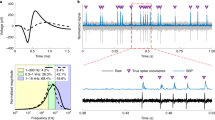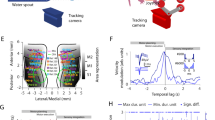Abstract
We describe three slow muscles that responded to low-frequency modulation of a high-frequency neuronal input and, consequently, could express the motor patterns of neural networks whose neurons did not directly innervate the muscles. Two of these muscles responded to different frequency components present in the same input, and as a result each muscle expressed the motor pattern of a different, non-innervating, neural network. In an analogous manner, the distinct dynamics of the multiple intracellular processes that most cells possess may allow each process to respond to, and hence differentiate among, specific frequency ranges present in broad-band input.
This is a preview of subscription content, access via your institution
Access options
Subscribe to this journal
Receive 12 print issues and online access
$209.00 per year
only $17.42 per issue
Buy this article
- Purchase on Springer Link
- Instant access to full article PDF
Prices may be subject to local taxes which are calculated during checkout




Similar content being viewed by others
References
Partridge, L. D. Signal-handling characteristics of load-moving skeletal muscle. Am. J. Physiol. 210, 1178–1191 (1966).
Smith, S. J., MacDermott, A. B. & Weight, F. F. Detection of intracellular Ca2+ transients in sympathetic neurones using arsenazo III. Nature 304, 350–352 (1983).
Gamble, E. & Koch, C. The dynamics of free calcium in dendritic spines in response to repetitive synaptic input. Science 236, 1311–1315 (1987).
Delaney, K. R., Zucker, R. S. & Tank, D. W. Calcium in motor nerve terminal associated with posttetanic potentiation. J. Neurosci. 9, 3558–3567 (1989).
Breer, H., Boekhoff, I. & Tareilus, E. Rapid kinetics of second messenger formation in olfactory transduction. Nature 345, 65–68 (1990).
Delaney, K. R. & Tank, D. W. A quantitative measurement of the dependence of short-term synaptic enhancement on presynaptic residual calcium. J. Neurosci. 14, 5885–5902 (1994).
Regehr, W. G., Delaney, K. R. & Tank, D. W. The role of presynaptic calcium in short-term enhancement at the hippocampal mossy fiber synapse. J. Neurosci. 14, 523–537 (1994).
Wang, S. S.-H, Alousi, A. A. & Thompson, S. H. The lifetime of inositol 1,4,5-triphosphate in single cells. J. Gen. Physiol. 105, 149–171 (1995).
Feller, M. B., Delaney, K. R. & Tank, D. W. Presynaptic calcium dynamics at the frog retinotectal synapse. J. Neurophysiol. 76, 381–400 (1996).
Helmchen, F., Imoto, K. & Sakmann, B. Ca2+ buffering and action potential-evoked Ca2+ signaling in dendrites of pyramidal neurons. Biophys. J. 70, 1069–1081 (1996).
Brezina, A., Orekhova, I. V. & Weiss, K. R. Control of time-dependent biological processes by temporally patterned input. Proc. Natl. Acad. Sci. USA 94, 10444–10449 (1997).
Fields, R. D., Eshete, F., Stevens, B. & Itoh, K. Action potential-dependent regulation of gene expression: temporal specificity in Ca2+, cAMP-responsive element binding proteins, and mitogen-activated protein kinase signaling. J. Neurosci. 17, 7252–7266 (1997).
Chatton, J.-Y, Cao, Y. & Stucki, J. W. Perturbation of myo-inositol-1,4,5-trisphosphate levels during agonist-induced Ca2+ oscillations. Biophys. J. 74, 523–531 (1998).
Wang, X.-J Calcium coding and adaptive temporal computation in cortical pyramidal neurons. J. Neurophysiol. 79, 1549–1566 (1998).
Pivovarova, N. B., Hangpaisan, J., Andrews, S. B. & Friel, D. D. Depolarization-induced mitochondrial Ca accumulation in sympathetic neurons: spatial and temporal characteristics. J. Neurosci. 19, 6372–6384 (1999).
Evans, P. D. & Siegler, M. V. S. Octopamine mediated relaxation of maintained and catch tension in locust skeletal muscle. J. Physiol. (Lond.) 324, 93–112 (1982).
Weiss, K. R. et al. Peptidergic cotransmission in Aplysia: functional implications for rhythmic behaviors. Experientia 48, 456–463 (1992).
Clarac, F. & Cattaert, D. Invertebrate presynaptic inhibition and motor control. Exp. Brain Res. 112, 163–180 (1996).
Stevenson, P. A. & Meuser, S. Octopaminergic innervation and modulation of a locust flight steering muscle. J. Exp. Biol. 200, 633–642 (1997).
Fields, D. R. & Nelson, P. G. Resonant activation of calcium signal transduction in neurons. J. Neurobiol. 25, 281–293 (1993).
Sheng, H. Z., Fields, R. D. & Nelson, P.G. Specific regulation of immediate early genes by patterned neuronal activity. J. Neurosci. Res. 35, 459–467 (1993).
Itoh, K., Stevens, B., Schachner, M. & Fields, R. D. Regulated expression of the neural cell adhesion molecule L1 by specific patterns of neural impulses. Science 270, 1369–1372 (1995).
Li, W., Llopis, J., Whitney, M., Zlokarnik, G. & Tsien, R. Y. Cell-permeant caged InsP3 ester shows that Ca2+ spike frequency can optimize gene expression. Nature 392, 936–941 (1998).
Dolmetsch, R. E., Xu, K. & Lewis, R. S. Calcium oscillations increase the efficiency and specificity of gene expression. Nature 392, 933–936 (1998).
Selverston, A. I., Russell, D. F., Miller, J. P. & King, D. G. The stomatogastric nervous system: Structure and function of a small neural network. Prog. Neurobiol. 7, 215–290 (1976).
Govind, C. K., Atwood, H. L. & Maynard, D. M. Innervation and neuro-muscular physiology of intrinsic foregut muscles in the blue crab and spiny lobster. J. Comp. Physiol. A 96, 185–204 (1975).
Maynard, D. M. & Selverston, A. I. Organization of the stomatogastric ganglion of the spiny lobster. IV. The pyloric system. J. Comp. Physiol. A 100, 161–182 (1975).
Sigvardt, K. A. & Mulloney, B. Sensory alterations of motor patterns in the stomatogastric nervous system of the spiny lobster Panulirus interruptus. J. Exp. Biol. 97, 137–152 (1982).
Kennedy, M. B. & Marder, E. in An Introduction to Molecular Neurobiology (ed. Hall, Z. H.) 463–495 (Sinauer, Sunderland, Massachusetts, 1992).
Turrigiano, G. G. & Heinzel, H.-G in Dynamic Biological Networks. The Stomatogastric Nervous System (eds. Harris-Warrick, R. M., Marder, E., Selverston, A. I. & Moulins, M.) 197–220 (MIT Press, Cambridge, Massachusetts, 1992).
Meyrand, P. & Moulins, M. Myogenic oscillatory activity in the pyloric rhythmic motor system of Crustacea. J. Comp. Physiol. A 158, 489–503 (1986).
Meyrand, P. & Marder, E. Matching neural and muscle oscillators: control by FMRFamide-like peptides. J. Neurosci. 11, 1150–1161 (1991).
Jorge-Rivera, J. C. & Marder, E. TNRNFLRFamide and SDRNFLRFamide modulate muscles of the stomatogastric system of the crab Cancer borealis. J. Comp. Physiol. A 179, 741–751 (1996).
Morris, L. G. & Hooper, S. L. Muscle response to changing neuronal input in the lobster (Panulirus interruptus) stomatogastric system: Spike number vs. spike frequency dependent domains. J. Neurosci. 17, 5956–5971 (1997).
Morris, L. G. & Hooper, S. L. Muscle response to changing neuronal input in the lobster (Panulirus interruptus) stomatogastric system: Slow muscle properties can transform rhythmic input into tonic output. J. Neurosci. 18, 3433–3442 (1998).
Mulloney, B. Organization of the stomatogastric ganglion of the spiny lobster. V. Coordination of the gastric and pyloric systems. J. Comp. Physiol. A 122, 227–240 (1977).
Russell, D. F. & Hartline, D. K. A multiaction synapse evoking both EPSPs and enhancement of endogenous bursting. Brain Res. 223, 19–38 (1981).
Claiborne, B. J. & Selverston, A. I. Localization of stomatogastric IV neuron cell bodies in lobster brain. J. Comp. Physiol. A 154, 27–32 (1984).
Maynard, D. M. & Dando, M. R. The structure of the stomatogastric neuromuscular system in Callinectes sapidus, Homarus americanus, and Panulirus argus (decapoda crustacea). Philos. Trans. R. Soc. Lond. B Biol. Sci. 268, 161–220 (1974).
Beltz, B. et al. Serotonergic innervation and modulation of the stomatogastric ganglion of three decapod crustaceans (Panulirus interruptus, Homarus americanus, and Cancer irroratus). J. Exp. Biol. 109, 35–54 (1984).
Flamm, R. E. & Harris-Warrick, R. M. Aminergic modulation in the lobster stomatogastric ganglion. I. Effects on the motor pattern and activity of neurons within the pyloric circuit. J. Neurophysiol. 55, 847–865 (1986).
Hooper, S. L. & Marder, E. Modulation of the lobster pyloric rhythm by the peptide proctolin. J. Neurosci. 7, 2097–2112 (1987).
Nusbaum, M. P. & Marder, E. A neuronal role for a crustacean red pigment concentrating hormone-like peptide: neuromodulation of the pyloric rhythm in the crab, Cancer borealis. J. Exp. Biol. 135, 165–181 (1988).
Dickinson, P. S. & Nagy, F. Control of a central pattern generator by an identified modulatory interneurone in Crustacea. II. Induction and modification of plateau properties in pyloric neurones. J. Exp. Biol. 105, 59–82 (1983).
Nusbaum, M. P. & Marder, E. A modulatory proctolin-containing neuron (MPN). II. State-dependent modulation of rhythmic motor activity. J. Neurosci. 9, 1600–1607 (1989).
Katz, P. S. & Harris-Warrick, R. M. Neuromodulation of the crab pyloric central pattern generator by serotonergic/cholinergic proprioceptive afferents. J. Neurosci. 10, 1495–1512 (1990).
Norris, B. J., Coleman, M. J. & Nusbaum, M. P. Pyloric motor pattern modification by a newly identified projection neuron in the crab stomatogastric nervous system. J. Neurophysiol. 75, 97–108 (1996).
Blitz, D. M. et al. Different proctolin neurons elicit distinct motor patterns from a multifunctional neuronal network. J. Neurosci. 19, 5449–5463 (1999).
Liu, Z., Golowasch, J., Marder, E. & Abbott, L. F. A model neuron with activity-dependent conductances regulated by multiple calcium sensors. J. Neurosci. 18, 2309–2320 (1998).
Turrigiano, G., Abbott, L. F. & Marder, E. Activity-dependent changes in the intrinsic electrical properties of cultured neurons. Science 264, 974–977 (1994).
Acknowledgements
This work was supported by Ohio University, NSF and NIMH. We thank R.A. DiCaprio for discussion and advice and A. L. Weaver for setting up the CED to stimulator interface and writing scripts to transform CED events into waveforms used to drive the stimulator.
Author information
Authors and Affiliations
Corresponding author
Rights and permissions
About this article
Cite this article
Morris, L., Thuma, J. & Hooper, S. Muscles express motor patterns of non-innervating neural networks by filtering broad-band input. Nat Neurosci 3, 245–250 (2000). https://doi.org/10.1038/72955
Received:
Accepted:
Issue Date:
DOI: https://doi.org/10.1038/72955
This article is cited by
-
Detection of Activation Sequences in Spiking-Bursting Neurons by means of the Recognition of Intraburst Neural Signatures
Scientific Reports (2018)
-
Co-variation of ionic conductances supports phase maintenance in stomatogastric neurons
Journal of Computational Neuroscience (2012)
-
Muscle anatomy is a primary determinant of muscle relaxation dynamics in the lobster (Panulirus interruptus) stomatogastric system
Journal of Comparative Physiology A (2007)
-
Neural Signatures: Multiple Coding in Spiking–bursting Cells
Biological Cybernetics (2006)
-
A small-systems approach to motor pattern generation
Nature (2002)



